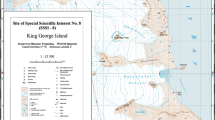Abstract
-
(i)
Aquatic macrophytes formed dense beds in fallow areas during the four and a half months of the flood season in all but one deepwater rice-growing location in Bangladesh; these included several types of life-form, but the fine-leaved species, Myriophyllum sp., Najas indica, Utricularia stellaris were often especially abundant. The same species grew inside deepwater rice fields, but at much lower densities. A similar contrast occurred for the algae, although deepwater rice often developed dense masses of epiphytes on aquatic roots, stems and leaf sheaths, when plants were growing in isolated, well-illuminated situations.
-
(ii)
Two widespread algae, Aulosira fertilissima and Scytonema mirabile, were equally successful on soil in the period prior to the arrival of floodwaters and floating on the surface of the water during the flood season. Other species common during the flood season differed from those common on soil.
-
(iii)
Most blue-green algae inside deepwater rice fields were heterocystous; the only species not so, but forming distinct colonies, was Aphanothece stagnina. However only non-heterocystous forms were found at one location in south Bangladesh (Phaltita) and a change from heterocystous to non-heterocystous forms was noted at the main research site (near Sonargaon) during late September in at least one year. The water column at the former was almost entirely anoxic, while the change at the latter occurred at a time when the water sometimes became anoxic during the night. It is suggested that differences in ability to tolerate anoxic periods may be a key factor in determining the success of the algal and vascular plant species in the different micro-habitats within these DWR-growing areas.
-
(iv)
Although diatoms were quantitatively only a minor component of the algal biomass, they became more frequent later in the season when the water became microaerobic or anoxic for part of the day. Navicula confervacea was overall the most abundant species at the two main research locations.
Similar content being viewed by others
References
Catling, H. D., P. R. Hobbs, Z. Islam & B. Alam, 1983. Agronomic practices and yield assessments of deepwater rice in Bangladesh. Field Crops Research 6: 109–132.
Catling, H. D., Z. Islam & B. Alam, 1982. Stand density in deepwater rice and its relation in yielding ability in farmers' fields in Bangladesh. In: Proceedings of the 1981 International Deepwater Rice Workshop. International Rice Research Institute, Los Baños, Laguna, Philippines: 179–188.
Catling, H. D., M. R. Martinez & Z. Islam, 1981. Survey of algae associated with deepwater rice in Bangladesh. Cryptogamie, Algologie 11 (2): 109–121.
Denny, P., 1985. The Ecology and Management of African Wetland Vegetation. Junk, Dordrecht, Boston, Lancaster: 344 pp.
Gibson, M. T. & B. A. Whitton, 1987. Hairs, phosphatase activity and environmental chemistry in Stigeoclonium, Chaetophora and Draparnaldia (Chaetophorales). Br. phycol. J. 22: 11–22.
Hasanuzzaman, S. M., 1975. Cultivation of deep-water rice in Bangladesh. In: Proceedings of International Seminar on Deep-water Rice. August 1974. Bangladesh Rice Research Institute: 137–147.
Islam, A. K., M. N. Anatunnesa & A. K. Haroon, 1980. Hydrobiological studies in and around Naogaon, Rajshabi. Dacca Univ. Stud. B 28 (2): 31–47.
Islam, A. K. M. N. & N. Paul, 1978. Hydrobiological study of the haor Hakaluki in Sylhet. J. Asiat. Soc. Bangladesh (Sci.) 3 (2): 83–91.
Kawecka, B., 1980. Sessile algae in European mountain streams. 1. The ecological characteristics of communities. Acta Hydrobiol. 22: 361–420.
Khan, M. S. (Ed.), 1972–1985. Flora of Bangladesh. Bangladesh Agricultural research Council, Dhaka.
Kulasooriya, S. A., P. A. Roger, W. L. Barraquio & I. Watanabe, 1981. Epiphytic nitrogen fixation on deepwater rice. Soil Sci. Plant Nutr. 27: 19–27.
Martinez, M. R. & H. D. Catling, 1982. Contribution of algae to the nutrition of deepwater rice. In: Proceedings of the 1981 International Deepwater Rice Workshop. International Rice Research Institute, Los Baños, Philippines: 201–214.
Whitton, B. A., 1987. The biology of Rivulariaceae. In The Cyanobacteria (Eds P. Fay and C. Van Baalen). Elsevier, Amsterdam: 513–534.
Whitton, B. A., A. Aziz, P. Francis, J. A. Rother, J. W. Simon & Z. N. Tahmida, 1988a. Ecology of deepwater rice-fields in Bangladesh. 1. Physical and chemical environment. Hydrobiologia 169: pp3–22.
Whitton, B. A. & H. D. Catling, 1986. Algal ecology of deepwater rice-fields in Thailand. Arch. Hydrobiol. 105: 289–297.
Whitton, B. A., J. A. Rother & A. R. Paul, 1988b. Ecology of deepwater rice-fields in Bangladesh. 2. Chemistry of sites at Manikganj and Sonargaon. Hydrobiologia
Whitton, B. A. & C. Sinclair, 1975. Ecology of blue-green algae. Sci. Progr., Oxf. 62, 429–446.
Author information
Authors and Affiliations
Rights and permissions
About this article
Cite this article
Whitton, B.A., Aziz, A., Kawecka, B. et al. Ecology of deepwater rice-fields in Bangladesh 3. Associated algae and macrophytes. Hydrobiologia 169, 31–42 (1988). https://doi.org/10.1007/BF00007931
Received:
Accepted:
Issue Date:
DOI: https://doi.org/10.1007/BF00007931




